Magic 2015 Prerelease Primer
The hunt is on! Garruk has become corrupted by the Chain Veil, a twisted shadow of his former self—and is out in the wilds, axe in hand. Any Planeswalkers that catch his eye become his prey. Will his next target be you?
Don't worry, everything should be okay. Garruk already managed to take down previous Prerelease Primer writer Mike McArtor, but it looks like you have a good head on your shoulders. (At least for the time being, anyway.) Follow my advice and we may just be able to get out of this bind.
Ready? All right, let's go!
Welcome to the Prerelease!
Prereleases always have been some of my favorite Magic tournaments.
A Prerelease was the first major event I ever went to back when I was eleven years old, and even today they still make me as excited as I was then. It's your first chance to play with the new cards before anybody else and get an edge over all your friends. And since it's brand new, it's an even playing field; people haven't dissected this format for weeks to figure out the optimal strategy. And most of all, it's a low-key, more casual event that's just a lot of fun!
If you're a Sealed Deck veteran, you may want to skip ahead to the next section, where I talk about some of the differences you can expect at your local store for Magic 2015. But if you're new to this whole crazy Sealed Deck shindig, or are maybe just looking for a few extra pointers, then read on.
Okay. So step one is you actually have to get to one of these mysterious "Prerelease" thingies (that's the technical term) in the first place.
If you don't already have a local shop you frequent, be sure to check out the store locator to find one near you! That store may even offer preregistration. Prereleases are one of the most popular events we put on, so be sure to check and see if the store preregisters. The best time to find out an event is full is decidedly not when you show up and learn you can't play, so be sure to look ahead.
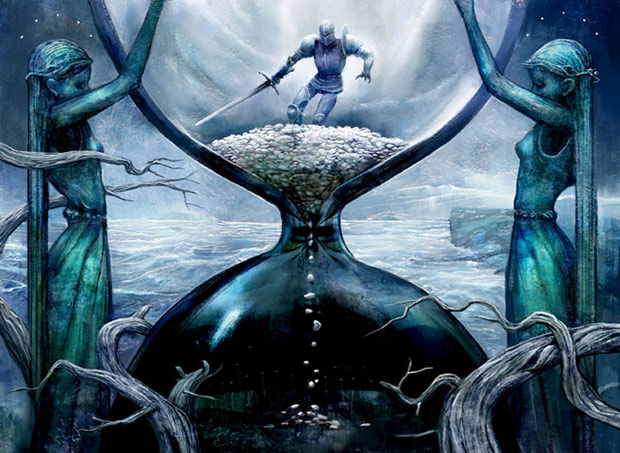
Chronostutter | Art by Seb McKinnon
Okay. Great. You've found your store—excellent!
Like any good hunter, make sure you have packed the appropriate supplies as well. While you will be building your deck for the event with cards you're given when you get there, you may still want to bring a deck to play between rounds for fun, a trade binder, pen and paper to keep track of life, and even a water bottle plus a few granola bars to snack on. Hey, hunting people down is hard work! You can expect a Prerelease event to take about four or five hours, so be prepared.
Okay, let's see. You have a store and you've packed your trusty bag with all of the essentials for a day out in the tournament wilderness. That can only mean one thing...
The Game is Afoot!
That's right: it's time to sit down, get your packs, and start building your deck.
The way the Prerelease works is simple: you choose a color, and then you will be handed a sweet-looking box of that color. Inside this box you'll find several things, but most key to actually helping you play at a Prerelease will be your various booster packs! (Five regular Magic 2015 boosters plus one rather special pack—but I'll get to that in a moment.)
Rip those packs open and you'll be left with a stack of cards. So, what now? Well it's time to build a deck!
Sealed Deck is a little different than normal deck building. You get to build a deck only out of the cards in front of you, plus as many basic lands as you'd like. Also, unlike a normal Constructed deck, you only have to play forty cards.
The first thing you'll want to do is sort your cards by color so you have an idea of how many of each you have. Even then, it might be a little intimidating—and that's where that special booster pack I mentioned earlier comes in!
When you picked your box you chose a specific color, and that color matches up with the contents of your special "seed booster" that is wrapped in plastic as you open your box. This "seeded deck" experience helps you figure out what colors to play. While that pack contains cards of all colors, it is slanted toward powerful cards in the color you chose—meaning that, if you don't know where to start, that color is a safe bet at being one of your most powerful.
Let's say you take that color, knowing it's a good choice, and you lay the creatures out in mana cost order. You can see an example (from Magic 2014) in the decklist below by clicking the Stats tab:
[decklist]
Title: Creature Mana Curve
Format:
Commander:
1 Soulmender
1 Angelic Wall
1 Capashen Knight
1 Imposing Sovereign
1 Sentinel Sliver
1 Banisher Priest
1 Ajani's Chosen
1 Charging Griffin
1 Pillarfield Ox
1 Dawnstrike Paladin
1 Stonehorn Chanter
[/decklist]
The next thing you want to do it look for what complements this color well. What holes might there be on the "mana curve" of this deck?
Well, if you look at the decklist above, you'll notice that there are pretty big gaps at three and at five. So, what you can do is look through your other colors and see if there are any colors in particular that line up well to fill in those gaps in the middle of your "mana curve." (Don't worry too much about one-mana creatures—we don't make many of those.) When you find a color that matches, you can use that as an indicator it'll be a good fit for your deck.
Another place for cards that complement what you're doing is to look for any spells (as indicated in the Type image under the Stats tab, above) that might help out what you're doing.
[decklist] Title: Mana Curve with Spells
Format:
Commander:
1 Soulmender
1 Angelic Wall
1 Capashen Knight
1 Imposing Sovereign
1 Sentinel Sliver
1 Banisher Priest
1 Ajani's Chosen
1 Charging Griffin
1 Pillarfield Ox
1 Dawnstrike Paladin
1 Stonehorn Chanter
1 Scroll Thief
1 Air Servant
1 Cancel
1 Divination
1 Traumatize
[/decklist]
For example, destroying your opponent's creatures is a really important thing to do in Sealed Deck. Red typically gets "burn" spells that deal damage and black gets straight-up removal spells, so that might help you fill in gaps in your white, blue, or green deck.
Interested in more tips like this? Here are a few more things to keep in mind for deck building:
- You can play more than forty cards, but you really should stick to forty if you can. Every card over forty you play just means it's that much less likely you're going to draw that awesome rare you put in your deck!
- The land ratio you're looking at should be about seventeen lands to twenty-three nonlands. This isn't right 100% of the time, but most Limited decks end up looking like this and, in general, it's what I would want to have.
- Stick to two colors. If you have a lot of "mana fixing" (cards that help produce another color of mana, like
Manalith ) you could consider playing a couple expensive/situational cards in a third color—but in general, I would stick to two colors. You're not going to be able to cast your spells often enough if you can't draw the right lands! - Play a mix of cheap-to-cast and expensive-to-cast cards. If you have all cheap, small creatures, a single big creature can shut you down, but if you have all expensive, large creatures you risk getting run over first. Stick to a mix that focuses on creatures with the casting cost of two, three, four, and five. More games of Sealed Deck are won by casting a creature every turn starting on turn two or three than any other way.
- Evasion is important! Often, Sealed Deck games will get into stalls where both players have a lot of creatures and neither player can attack very well. Creatures with abilities like flying ensure that you can break through these creature stalls.
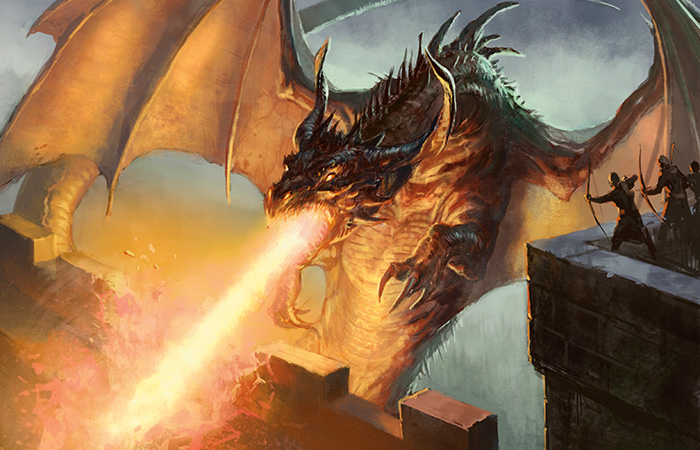
Siege Dragon | Art by Karl Kopinski
If you want to dive really deep into Sealed, here are a few articles you can check out to learn even more:
- "How I Break Down My Sealed Pool"
- "Prerelease Prerogatives"
- "Sealed Deck Reality Check"
- "Foundations"
- Nate Price's Price of Progress series
- "Prerelease Primer" (the original)
Two-Headed Giant
Some stores also support a version of Sealed Deck called Two-Headed Giant (often abbreviated "2HG"), where two players team up against other pairs of players. Each pair gets two Prerelease Packs (they don't have to be the same ones, even!) from which the players build their decks. Your tournament organizer can tell you more about 2HG if your store supports it.
Open Dueling
If the idea of spending a day playing a tournament scares you, or you just want to experience more games with Magic 2015, you can get involved in Open Dueling.
In this side event, you get a ready-to-play sixty-card Intro Deck and use it to do battle against others participating in Open Dueling, including players participating in the main tournament who are between rounds! This is a great way to dip your toe into the water if you aren't sure the Prerelease is something you want to do, or if you can't commit five hours to a Prerelease event; you can just play games in Open Dueling at your own leisure. Plus, it's fun!
We Interrupt This Article for Some Shiny Goodness...
Okay, so I figured it was time for a brief break from all of this strategy stuff so I could show off some of the super-cool stuff you can expect to find inside your Prerelease box. Namely, the shiny premium cards.
Depending on which box you pick, you'll get a different foil rare that you can play with in your deck. Want to be guaranteed to smash face with a Dragon? This is your chance!
Let's take a look at what you can expect from each of the boxes.
If you choose to Hunt with Valor (white), you get this awesome Angel:

If you choose to Hunt with Guile (blue), you can expect a bit of trickery:
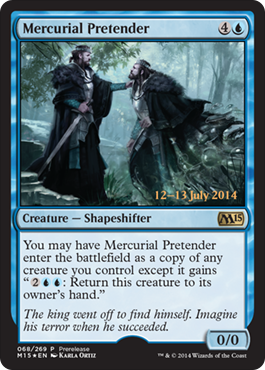
If you choose to Hunt with Ambition (black), you can create a Demon that puts your opponent in a bind:
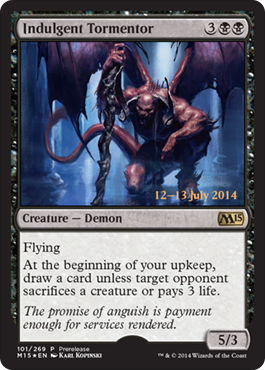
If you choose to Hunt with Ferocity (red), you can get your hands on the aforementioned Dragon:
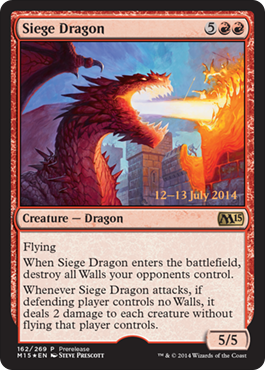
And finally, if you choose to Hunt with Strength (green), you end up with this unkillable fella:

Of course, you also get an awesome-looking Spindown™ d20. Oh, and no matter which you choose, you'll end up with one of these. It might be a good time to hold onto your head—because Garruk is coming for you!

The Hunt
What in the world?!? What is this gigantic Garruk card doing in your box?
It's the key component of Magic 2015's experience design—and one of the coolest experiences we've made yet. Designed by Ethan Fleischer and Gavin Verhey (hey, that's me! Hi Mom!), then developed by Adam Prosak, it's an easy-to-learn, fast, and replayable experience that pits you against Garruk or even lets you play as Garruk, if you'd rather join the side of the hunter!
It's simple: one player plays his or her Prerelease Magic deck as normal. This player always goes first. Pretty straightforward. The other player, however, plays as Garruk! Garruk starts at 20 loyalty, and can activate one loyalty ability each turn.
Like any other Planeswalker, Garruk can be attacked—and if his loyalty reaches 0, he loses. But if Garruk's horde of Wolves drops the player to 0, then Garruk wins! (And no, the oversized Garruk Planeswalker card can't be returned to its owner's hand or otherwise removed—nice try.)
A game against Garruk doesn't take too long, and is a fantastic activity for in-between rounds of the Prerelease.
And speaking of Garruk, you may also notice that your store has a gigantic eight-foot-tall Garruk standee that looks a little something like this:
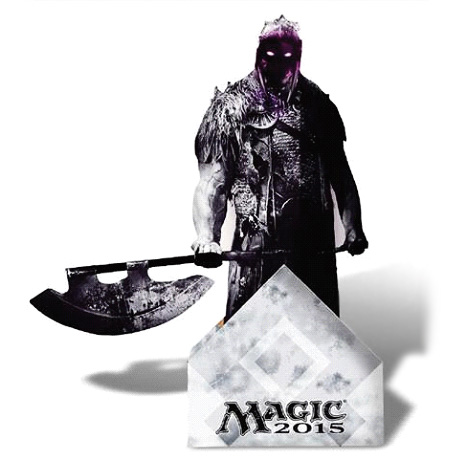
After your game, go take a picture next to Garruk—perhaps in a victory or defeat position depending on how your game went—and then upload it to www.HuntBiggerGame.com. (Also, feel free to show it off on Facebook or Twitter with the hashtags #magic2015 and #huntbiggergame.)
You can read the full terms and conditions here. In short: play against Garruk, have fun, take a picture with Garruk, enter to win free axe. Pretty sweet? I think so!

Convokomplications
Magic 2015 features one returning mechanic we haven't seen for a while: convoke! Last seen way back in Future Sight for a brief cameo appearance in 2007, and originally in 2005's Ravnica: City of Guilds, it's back once more with a bunch of brand-new cards. And this time it's in every color!
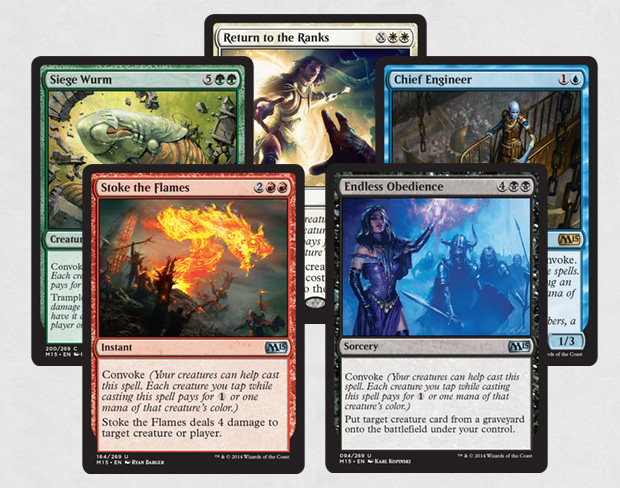
If you're not sure what exactly convoke does, here's a look at the rules behind convoke:
The Magic 2015 Core Set features the return of convoke, first used by the Selesnya guild in Ravnica: City of Guilds. Convoke lets your creatures help you cast spells when you might be a little short on mana. While casting a spell with convoke, instead of just paying mana, you can also tap creatures you control. Each one you tap pays for
You tap the creatures at the same time you pay the mana. This means that if one of your creatures has the ability to tap for mana, like
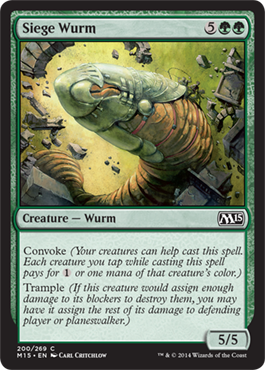

The Hunter Games
The Magic 2015 Prerelease takes place at stores around the world this weekend! Go and check it out—Prereleases are some of the most fun you can have playing Magic.
I covered most of what you can expect to find at a Prerelease, but there still yet may be a few surprises to uncover. Oh, and if you want to take a closer look at what's in the set, don't miss the Card Image Gallery, where you can check out every card in Magic 2015 in all its glory!
If you have any questions at all, feel free to post in the forums or send me a tweet and I'll be sure to help you out however I can. Whether you're looking for Sealed Deck help or just want to understand how the oversized Garruk activity works, I can provide the answers you seek.
Have fun this weekend, and may the odds be ever in your favor!
Gavin
@GavinVerhey

